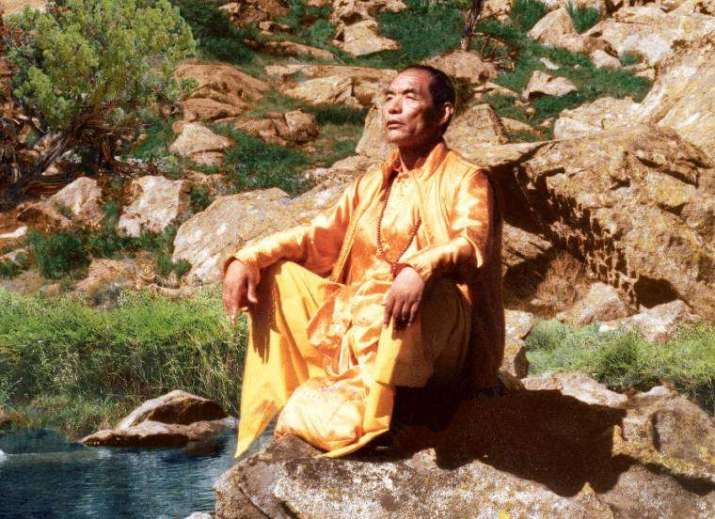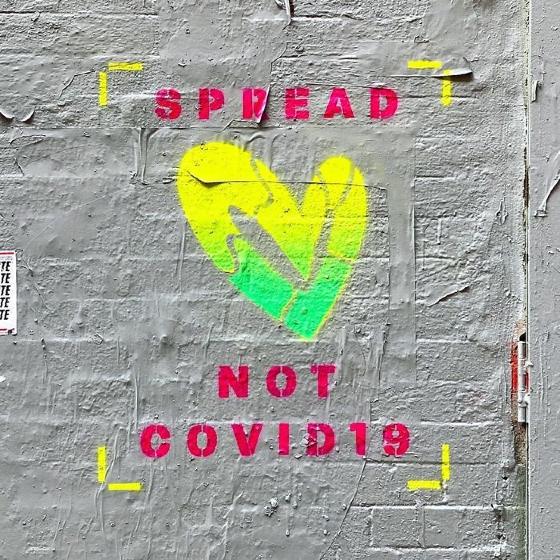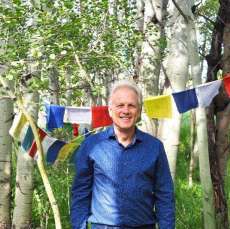Erric Solomon is a Buddhist yogi, teacher, and a former Silicon Valley technologist. Erric has studied under the guidance of some of the world’s greatest Tibetan spiritual masters, with some of the world’s best artificial intelligence researchers, and later spent years in Buddhist retreat maturing what he learned. He is co-author of Radically Happy: A User’s Guide to the Mind. More about Erric and his work can be seen at RadicallyHappy and Samye Institute, and on Facebook and Instagram.
FEATURES|THEMES|Health and Well-being
Coping with Fear, Anxiety, and Panic During the Pandemic
During this current health crisis caused by the spread of COVID-19, nearly all of us have experienced moments of fear and anxiety. Perhaps it was concern for the health of a loved-one, the loss of a job, or a general sense of dread due to imagining a dystopian future. And that is probably just the tip of the anxiety iceberg! How can we manage panic, fear, and anxiety? The first thing we can do is to understand what these feelings really are, and then we can use our minds to settle into a state of equipoise. The good news is that anyone can learn to do this.
Fear, panic, and anxiety are energy
For example, a sense of panic or fear is not necessarily a bad thing. But how we deal with panic can make a huge difference. Panic—or fear, or anxiety—is energy, a kind of bodily sensation that is a warning of possible danger, or an extreme situation about which we need to be on guard.
Of course, we can overreact, perhaps doing harmful, selfish things under the guise of self-preservation. Or we might become so overwhelmed by fear that we freeze up and are unable think straight or even move.

Los Angeles. Mural artist: Jules Muck. From boredpanda.com
Feeling the fear
Feeling fearful, anxious, or panicked is a wakeup call; we should take it seriously. But try feeling it, instead of thinking about it. This means noticing your bodily sensations. Is your heart racing? Is there a place in your body where the feeling of panic resides? When we can feel the fear instead of thinking about it, we begin to experience fear beyond our turbulent thoughts and emotions. The fear is energy, and energy is wisdom’s radiance. It is within the energy rather than the story that we will find the inner resilience to make it through: to find the appropriate action to take, to be mindful to wash our hands and not touch our face, to check on a sick or elderly neighbor. It is there that we will find the self-love, the compassion for others, and the most beneficial thoughts, feelings, and actions.
A dog or a lion?
One of my teachers, Nyoshul Khen Rinpoche, often used an ancient Dzogchen metaphor when teaching us how we should treat our thoughts and emotions. He always said that we should be like a lion, rather than a dog. When you throw a stone at a dog, the dog chases the stone. This is how we are with our thoughts and emotions. We chase every thought and emotion and play with it, think about it, get into it. On the other hand, if you throw a stone at a lion, the lion doesn’t care about the stone at all, but turns to look at where the stone came from.
 Nyoshul Khen Rinpoche. From the Tertön Sogyal Trust. Image courtesy of the author
Nyoshul Khen Rinpoche. From the Tertön Sogyal Trust. Image courtesy of the authorWe can spend our whole life preoccupied with stones—our thoughts and emotions. We may never even look at the source of the thoughts and emotions, the mind itself. So when we feel fearful or panicky, our habit is to think about the story, the reasons why we are panicked, rather than looking at the mind that feels the panic.
 From wallpapersafari.com
From wallpapersafari.comGetting to know your mind
Take a moment to investigate your mind. Do you know you are anxious? At first, this might seem like a question that is so obvious it isn’t worth asking. That knowing quality of mind, does it know the anxiousness better or worse than when it knows that you feel relaxed and peaceful? The more we investigate, the more familiar we become with the aware quality of mind that defines being sentient. The quality of awareness that knows panic isn’t different from the knowing of peace. In other words, we can see that our awareness is not harmed or enhanced by that of which we are aware. Isn’t that a comfort?
Therefore, let us turn our attention away from the story and gradually toward the mind, the knower of the fear.
The first step is a powerful exercise called “creating space.” This exercise is an excellent way to deal with our stress, fear, and looping panicky thoughts. It can relieve the tension and uptightness in our mind and also in our body. Creating space is a very simple method that interrupts habitual patterns of thinking about our thoughts and emotions and our fears and worries.
When our mind is fearful or panicky, it becomes very closed in and tight. It becomes a negativity feedback loop. When our mind is tight, any thought or emotion that arises dominates. So fear makes our mind tight, and a tight mind makes the fear more and more predominant. When our mind feels spacious, then the fear or panic that arises can’t completely take over. It is like the difference between a tiny three meter by three meter room and a huge 30 meter by 30 meter room. In the tiny room, anything you place there completely defines it. If you put a desk in there, it becomes an office. If you put a bed in there, it’s a bedroom. If you put a stove in, it’s a kitchen. In a huge room, you can have many things, and different environments, yet no single thing defines the room. When we create space, thoughts and emotions such as panic or fear can still appear, but they no longer completely define our state of mind.
Here is how to do the Creating Space exercise, from Radically Happy: A User’s Guide to the Mind (Shambhala 2018):
Sit comfortably and close your eyes.
Imagine being surrounded by an infinite, perfectly clear, blue sky. The sky is cloudless, spacious, pristine, the deepest sky-blue color. It completely envelops you, extending ceaselessly in every direction—above, below, and to every side. There are no walls, no boundaries, and no buildings, nothing at all in any direction.
Continue resting your mind on this infinite sky by making the experience of spaciousness as vivid and vibrant in your mind’s eye as possible.
If you become lost in thinking about work, things you need to do, or anything really, that’s normal. Just gently return your attention to imagining boundless space.
Having created a sky as vividly and clearly as possible, spend some time appreciating the space you’ve imagined. Do this by feeling the spacious quality of the sky. Appreciate the beauty of the space you’re imagining and how infinitely vast, spacious, and immaculate the sky around you is. You don’t have to go on and on about it. Just gently try to feel how it is to be in the spaciousness of the sky.
Allow yourself to feel the spaciousness permeating everywhere: inside and outside your body and the mind.
Rest for a little while in this feeling.
Slowly open your eyes and reorient yourself to your surroundings.
Try the exercise out for a few days, until you begin to feel an opening, a sense of spaciousness. Don’t be concerned if some anxiousness persists. In infinite space a little anxiety or fear is just a small ripple in an infinitely spacious situation. Now you are ready for the next step: feeling panic instead of thinking about the story or the reasons for being anxious.

New York. Art by Jason Naylor. From boredpanda.com
Feeling the sensation of fear, panic, or anxiety
Sit quietly in meditative equipoise for a few minutes or “create space.”
Now allow yourself to feel the sensation of fear, instead of just thinking about all the reasons to be panicked. Gently scan your body, starting from the top of your head down. Where in the body does the feeling of fear reside? When you locate it, you don’t need to push it away, just feel it. You can think of it as loving yourself so much that you allow for whatever is there to be there. Instead of thinking of the reasons for feeling fearful, just feel the fear. When you place your attention on the feeling, instead of a story, it becomes a mere sensation, or you could call it energy. Inside the fear is energy, the expression of our wisdom, our love, our intelligence. Within our awareness, all these things are there, confusion and wisdom. By placing your attention in a very specific way, you can uncover the wisdom that is the basis of difficult emotions, even panic. All you have to do is feel the energy of panic in our body, rather than thinking about the story in your mind.
If you’d like, you can make aspirations and dedications according to your tradition of practice.
By simply allowing the sensation of fear to be how it is, without the story, you are liberated from the power of the story. It is important to begin by creating space, that way, even if there’s a little story left, it’s just a little tiny story in infinite space. It can’t overwhelm, predominate, control, or define you anymore. Again and again come back to space and come back to allowing it to be how it is; feeling how you feel rather than the story. When you allow yourself to simply feel how you feel, it becomes mere energy, a mere sensation in a wide open, spacious situation. Equipoise arises as a natural consequence of the spacious open quality of wisdom.
Given our current situation, it is quite natural that our emotions are all over the place. This practice is an invaluable way to simply be with how things are. After you become used to just feeling the sensation of the anxiety, rather than the story, you will discover a well-spring of resilience to help you make it through all the challenges of this current situation.
To paraphrase the great saint Shantideva: “Why worry? If there is something to do that can help, do it, but if there isn’t, worrying won’t make it better.” The good news is you can do something: you can listen to your body, and let the radiance of your wisdom nature guide you (and follow the advice of healthcare professionals).
 Erric Solomon
Erric SolomonSee more
Erric Solomon: Going beyond fear, panic and dis-ease (YouTube)
Related features from Buddhistdoor Global
Cognitive Apparatus and the Nature of the Mind in Tibetan Buddhism
Wrestling with the Big and the Small
Being Like a Mountain: What Hokusai’s The Great Wave Says About Remaining Calm in Troubled Times
What to Do with this World?
Metta’s Walk in the Park
See all coronavirus-related content from Buddhistdoor Global














